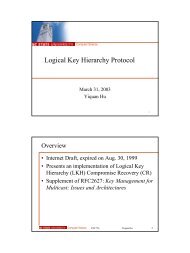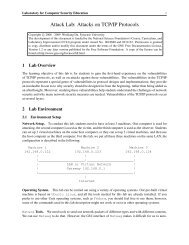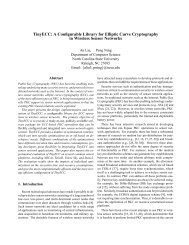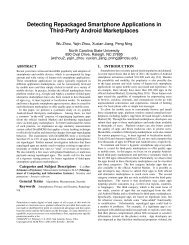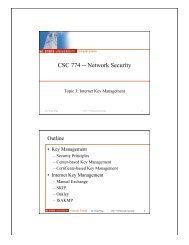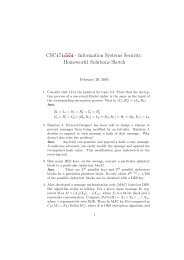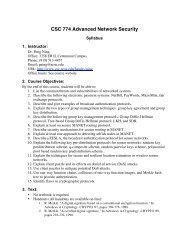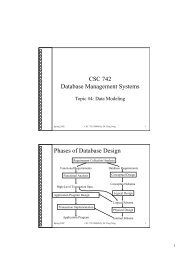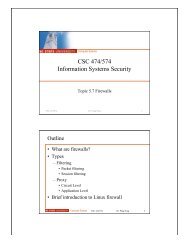Correlating Alerts Using Prerequisites of Intrusions - Dr. Peng Ning ...
Correlating Alerts Using Prerequisites of Intrusions - Dr. Peng Ning ...
Correlating Alerts Using Prerequisites of Intrusions - Dr. Peng Ning ...
Create successful ePaper yourself
Turn your PDF publications into a flip-book with our unique Google optimized e-Paper software.
attack.<br />
The problem in hyper-alert generation can be partially addressed by standards such as Intrusion Detection<br />
Message Exchange Format (IDMEF) [4]. We expect that the hyper-alert generation program can correctly<br />
understand the alerts generated by the IDSs that support IDMEF. However, not all the problems can be addressed<br />
by IDMEF. <strong>Alerts</strong> in different granularities are still allowed, and multiple alerts may be generated<br />
for a single attack. To address this problem, we propose to allow hyper-alert aggregation during the generation<br />
<strong>of</strong> hyper-alerts. For example, hyper-alerts <strong>of</strong> the same type can be aggregated into a single hyper-alert<br />
provided that the resulting hyper-alert satisfies certain duration constraint or interval constraint. Hyper-alerts<br />
<strong>of</strong> different types may also be aggregated into a compound hyper-alert if certain given conditions are satisfied.<br />
Existing alert correlation techniques [5, 20] may be adopted for this purpose. Additional research is<br />
necessary to decide when to use hyper-alert aggregation and what kind <strong>of</strong> aggregations are necessary.<br />
5.3 Processing <strong>of</strong> Hyper-alerts<br />
To correlate hyper-alerts using prerequisites <strong>of</strong> intrusions requires to discover all pairs <strong>of</strong> hyper-alerts such<br />
that one hyper-alert prepares for the other. A naive approach is to check each hyper-alert with all the others<br />
to find out all the hyper-alerts that it prepares for. However, this approach could be very expensive if a large<br />
amount <strong>of</strong> hyper-alerts are being discovered. Indeed, given n hyper-alerts, we will have n 2 pairs <strong>of</strong> hyperalerts,<br />
each <strong>of</strong> which further requires reasoning about the predicates in the prerequisite and consequence<br />
sets. This is certainly not a scalable solution.<br />
An engineering method to improve the naive approach is to only consider the hyper-alerts that are close<br />
to each other in time. In practice, a threshold T <strong>of</strong> time duration may be used; we check a hyper-alert with a<br />
previous one only if the time difference between them is less than T . This method is based on the assumption<br />
that attacks far from each other tend not to correlated to each other. Although the assumption could be true<br />
most <strong>of</strong> time, exceptions still exist. For example, intrusive activities involved in a series <strong>of</strong> stealthy attacks<br />
may be far from each other, simply because the attacker does not want to draw any attention. Relaxing the<br />
threshold T is one way to better correlate the attacks; however, the larger T is, the more expensive it is to<br />
process the hyper-alerts, and there will be a limit <strong>of</strong> T due to the constraint <strong>of</strong> system resources. Therefore,<br />
additional techniques are desirable to reduce the cost <strong>of</strong> hyper-alert processing.<br />
In our initial implementation [14], we used the database management system (DBMS) to help process the<br />
alerts and hyper-alerts stored in the database. In other words, we represent the operations to be performed<br />
on hyper-alerts as SQL statements and let the DBMS handle all the operations. Such a method performs<br />
well for <strong>of</strong>f-line correlation <strong>of</strong> alerts; however, it will suffer from severe performance penalty when it is used<br />
to process alerts in real-time.<br />
Two approaches may be used to improve the hyper-alert processing. First, we may use the hyper-alert<br />
type information to help decide whether to check two hyper-alerts or not. Note that a hyper-alert instance<br />
<strong>of</strong> type T 1 may prepare for another hyper-alert instance <strong>of</strong> type T 2 only if the consequence set <strong>of</strong> T 1 may<br />
imply a predicate in the prerequisite set P (T 2 ). Specifically, we say that hyper-alert type T 1 may prepare<br />
for hyper-alert type T 2 if there exist h 1 , which is a hyper-alert <strong>of</strong> type T 1 , and h 2 , which is a hyper-alert <strong>of</strong><br />
type T 2 , such that h 1 prepares for h 2 . Thus, we check hyper-alerts h 1 and h 2 only when the type <strong>of</strong> h 1 may<br />
prepare for the type <strong>of</strong> h 2 or vice versa.<br />
The second possible enhancement is to adapt in-memory database query optimization techniques (e.g.,<br />
in-memory hybrid hash join [7], T-Tree [17]) to assist hyper-alert processing. In the simplest case where<br />
we do not allow reasoning about the predicates, the discovery <strong>of</strong> prepare-for relation between hyper-alerts<br />
can be transformed to a search problem. Thus, database query optimization techniques can be applied<br />
directly to process hyper-alerts. Specifically, by building indexes on the elements <strong>of</strong> the consequence sets<br />
16




